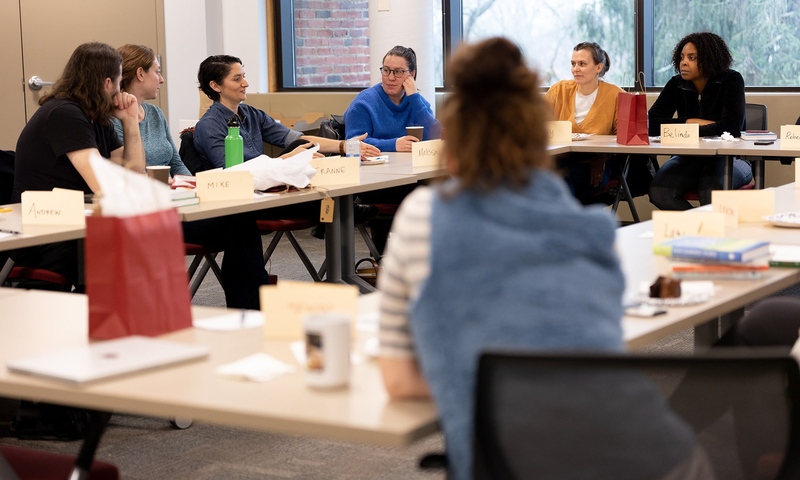
Rebecca N. Homan
Professor
Degree(s)
B.A., Wellesley College; Ph.D., Tufts University
Learning & Teaching
Courses
- Biology 230: Ecology & Evolution
- Biology 312: Herpetology
- Biology 352: Conservation Biology
- Biology 361/2: Directed Study
- Biology 451: Senior Research
- Biology 452: Advanced Senior Research
- AC 101: Advising Circles
- W 101: Facts, Fear, or Hope: Communicating Persuasively about Climate Change
Academic Positions
- Professor of Biology 2019-Present
Denison University, Granville, OH - Chair of Biology Department 2019-2022
Denison University, Granville, OH - Associate Professor of Biology 2010-2019
- Assistant Professor of Biology 2004-2010
Denison University, Granville, OH - Visiting Assistant Professor of Biology 2003-2004
Denison University, Granville, OH
Research
My research focuses on understanding the habitat requirements of pond-breeding amphibians, as well as on expanding the ways in which effects of habitat loss can be measured and monitored. Wetlands themselves have gained some protection in recent years, however many wetland organisms, including amphibians, rely heavily on the terrestrial upland. It is crucial to the protection of native wetland species that we understand both the quantity and quality of terrestrial habitat required to support a healthy population. Many pond-breeding amphibians, particularly Ambystoma species, can live for a decade or more, and this long life span can make traditional population studies challenging. Developing alternative techniques that can supplement, or in some time sensitive cases, replace traditional population studies may aid in the relatively rapid identification of at-risk populations, as well as enable the implementation of more effective management strategies. To that end, I am currently planning several experiments including a long-term population study of a pond-breeding salamander (A. maculatum) and several studies of potential rapid assessment techniques for identifying populations at risk of severe decline or extinction at local ponds.
Works
Publications
Research Papers
- Reinke, B., Cayuela, H., Janzen, F.J., Lemaître, J.-F., Gaillard, J.M., Lawing, A.M., Iverson, J.B., Christiansen, D.G., Solano, I.M., Sánchez-Montes, G., Gutiérrez-Rodríguez, J., Rose, F.L., Nelson, N., Keall, S., Crivelli, A.J., Nazirides, T., Grimm-Seyfarth, A., Henle, K., Mori, E., Guiller, G., Homan, R., Olivier, A., Muths, E., Hossack, B.R., Bonnet, X., Pilliod, D.S., Lettink, M., Whitaker, T., Schmidt, B.R., Gardner, M.G., Cheylan, M., Poitevin, F., Golubović, A., Tomović, L., Arsovski, D., Griffiths, R.A., Arntzen, J.W., Baron, J.-P., Le Galliard, J.-F., Tully, T., Luiselli, L., Capula, M., Rugiero, L., McCaffery, R., Eby, L.A., Briggs-Gonzalez, V., Mazzotti, F., Pearson, D., Lambert, B.A., Green, D.M., Jreidini, N., Angelini, C., Pyke, G., Thirion, J.-M., Joly, P., Léna, J.-P., Tucker, T., Limpus, C., Priol, P., Besnard, A., Bernard, P., Stanford, K., King, R., Garwood, J., Bosch, J., Souza, F., Bertoluci, J., Famelli, S., Grossenbacher, K., Lenzi, O., Matthews, K., Boitaud, S., Olson, D.H., Jessop, T.S., Gillespie, G., Clobert, J., Richard, M., Valenzuela-Sánchez, A., Fellers, G.M., Kleeman, P.M., Brian J. Halstead, B.J., Grant, E.H.C., Byrne, P.G., Frétey, T., Le Garff, B. Levionnois, B.P., Maerz, J.C., Pichenot, J., Olgun, K. Üzüm, N., Avcı, A., Miaud, C., Elmberg, J., Brown, G.P., Shine, R., Bendik, N.F., O’Donnell, L., Davis, C.L., Lannoo, M.J., Stiles, R.M., Cox, R.M., Reedy, A.M., Warner, D.A., Bonnaire, E., Grayson, K., Ramos-Targarona, R., Baskale, E., Muñoz, D., Measey, J., de Villiers, F.A., Selman, W., Ronget, V., Bronikowski, A.M., and David A. W. Miller, D.A.W. 2022. Diverse aging rates in ectotherms provide insights for the evolution of aging and longevity. Science 376: 1459-1466.
- Cayuela, H., Lemaître, J.-F., Léna, J.-P., Ronget, V., Solano, I.M., Muths, E., Pilliod, D.S., Schmidt, B.R., Sánchez-Montes, G., Gutiérrez-Rodríguez, J., Pyke, G., Grossenbacher, K. Lenzi, O., Bosch, J., Beard, K.H., Woolbright, L.L., Lambert, B.A., Green, D.M., Garwood, J.M., Fisher, R.N., Matthews, K., Dudgeon, D., Lau, A., Speybroeck, J., Homan, R., Jehle, R. Başkale, E., Mori, E., Arntzen, J.W., Joly, P., Stiles, R.M., Lannoo, M.J., Maerz, J.C., Lowe, W.H., Valenzuela-Sánchez, A., Christiansen, D.G., Angelini, C., Thirion, J.-M., Merilä, J., Colli, G. R., Vasconcellos, M.M., Boas, T.C.V., da C. Arantes, I., Levionnois, P., Reinke, B. A., Vieira, C., Marais, G.A.B., Gaillard, J.M., and Miller, D.A.,W.. 2022. Sex-related differences in aging rate are associated with sex chromosome system in amphibians. Evolution 76:346-356.
- Homan, R.N. 2019. Climate-related correlates of several metrics of breeding phenology in a Spotted Salamander (Ambystoma maculatum) population in Ohio. Journal of Herpetology 53:257-262.
- Homan, R.N., M.A. Holgerson, and L.M. Biga. 2018. A long-term demographic study of a spotted salamander (Ambystoma maculatum) population in central Ohio. Herpetologica 74:109-116.
- Homan, R.N., J.R. Bartling*, R.J. Stenger,*, and J.L. Brunner. 2013. Detection of Ranavirus in Ohio, USA. Herpetological Review 44:615-618.
- Homan, R.N., M.A. Atwood, A.J. Dunkle, and S.B. Karr. 2010. Movement orientation by adult and juvenile wood frogs (Rana sylvatica) and American toads (Bufo americanus) over multiple years.. Herpetological Conservation and Biology. v. 5 no. 1 p. 64-72
- Homan, R.N., C.D. Wright*, G.L. White*, L.F. Michael*, B.S. Slaby*, and S.E. Edwards*. 2008. Multiyear study of the migration orientation of Ambystoma maculatum (Spotted Salamanders) among varying terrestrial habitat. Journal of Herpetology. v. 42 p. 600-607
- Windmiller, B., R.N. Homan, J. V. Regosin, L. A. Willitts, D. L. Wells and J. M. Reed. 2008. Two Case Studies of Declines in Vernal Pool Breeding Amphibian Populations Following Loss of Adjacent Upland Forest Habitat. Herpetological Conservation: Urban Herpetology . v. 3 p. 41-51
- Homan, R.N., B. S. Windmiller, and J. M. Reed. 2007. Comparative life histories of two sympatric Ambystoma species at a breeding pond in Massachusetts. Journal of Herpetology. v. 41 p. 401-409
- Regosin, J.V., B.S. Windmiller, R.N. Homan, and J.M. Reed. 2005. Variation in terrestrial habitat use among four pool-breeding amphibian species and its conservation implications. Journal of Wildlife Management. v. 69 p. 1481-1493
- Homan, R.N., J.M. Reed, and B.S. Windmiller. 2004. Critical thresholds associated with habitat loss for two vernal pool-breeding amphibians. Ecological Applications. v. 14 p. 1547-1553
- Homan, R.N., J.M. Reed, and L.M. Romero. 2003. Corticosterone concentrations in free-living spotted salamanders (Ambystoma maculatum). General and Comparative Endocrinology. v. 130 p. 165-171
- Homan, R.N., J.V. Regosin, D.M. Rodrigues*, J.M. Reed, B.S. Windmiller, and L.M. Romero. 2003. Impacts of varying habitat quality on the physiological stress of Spotted Salamanders (Ambystoma maculatum). Animal Conservation. v. 6 p. 11-18
- Homan, R.N., J.M. Reed, and B.S. Windmiller. 2003. Analysis of spotted salamander (Ambystoma maculatum) growth rates based on long-bone growth rings. Journal of Herpetology. v. 37 p. 617-621
Presentations
- Homan, R.N. 2018. Relationships between local climate variables and spotted salamander phenology differ for early versus median breeders. North American Congress for Conservation Biology.
- Homan, R.N. 2016. A decade-long demographic study of a Spotted Salamander population in central Ohio. 101st Annual Meeting of the Ecological Society of America.
- Reding, J.A., G.R. Smith, J.E. Rettig, R.N. Homan, D.J. Spieles, T.D. Schultz, A.C. McCall, and B.J. Sodergren. 2016. The Granville Schools Land Lab: A K-12/College/Government Teaching and Research Collaboration. 101st Annual Meeting of the Ecological Society of America.
- Homan, R.N., J.R. Bartling*, R.J. Stenger*, and J.L. Brunner. 2013. Detection of ranavirus in five amphibian species among three Ohio ponds. 98th Annual Meeting of the Ecological Society of America.
- Homan, R.N. 2012. Fluctuation and Stability: A seven year study of spotted salamander demography and migratory orientations. Ohio Amphibian Research and Conservation Conference.
- Homan, R.N. 2011. Multiyear demographic study of three co-occurring pond-breeding amphibian species. 96th Annual Meeting of the Ecological Society of America.
- Rumschlag, S.L*, T. Lan*, and R.N. Homan. 2010. A pilot study examining the role of conspecific chemical cues affecting juvenile American toad (Bufo americanus) orientation behavior. 95th Annual Meeting of the Ecological Society of America.
- Homan, R.N., M.A. Atwood*, A. Dunkle*, and S.Karr.* 2009. Multi-year study of adult and juvenile Wood Frog and American Toad migration orientations. 94th Annual Meeting of the Ecological Society of America.
- Homan, R.N., C.D. Wright*, L.F. Michael*, and S.A. Edwards*. 2007. Distribution of Ambystoma maculatum among different habitat types surrounding a single breeding pond. 92nd Annual Meeting of the Ecological Society of America.
- Homan, R.N., C. D. Wright*, and D. Walker*, 2006. Correlates of location and movement of Spotted Salamanders (Ambystoma maculatum) in the breeding pond. Joint Meeting of Ichthyologists and Herpetologists.
- Wright, C. D.* and R.N. Homan, 2006. Demographic correlates between upland and wetland usage in Ambystoma maculatum. 115th Annual Meeting of the Ohio Academy of Sciences.
- Homan, R.N., B.S. Windmiller, and J.M. Reed, 2004. Demographic clues about differences in relative vulnerabilities of two sympatric Ambystoma species. 18th Annual Meeting of the Society for Conservation Biology.
- Homan, R.N., B.S. Windmiller, and J.M. Reed, 2003. Critical Thresholds Associated with Habitat Loss for Two Vernal Pool-Breeding Amphibians. 17th Annual Meeting of the Society for Conservation Biology.
- Newcomb Homan, R., B.S. Windmiller, and J.M. Reed, 2001. Demographic Consequences of Upland Habitat Loss on Two Ambystoma Species in Eastern Massachusetts. 86th Annual Meeting of the Ecological Society of America.
- Newcomb Homan, R., B.S. Windmiller, and J.M. Reed. 1999. The Effects of Upland Habitat Loss on two Species of Mole Salamander (Ambystoma laterale and A. maculatum). Joint Meeting of the American Society of Ichthyologists & Herpetologists, American Elasmobranch Society, Herpetologists League, and Society for the Study of Amphibians & Reptiles.
* indicates student coauthor
Other
Honors & Awards
- John and Christine Warner Professor (2019-2022)
- Charles A. Brickman Teaching Excellence Award recipient (2017)
- R. C. Good Faculty Fellowship (2017-2018)
- Bayley-Bowen Faculty Fellow (2007-2010)



